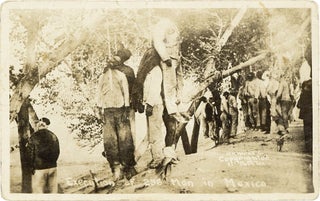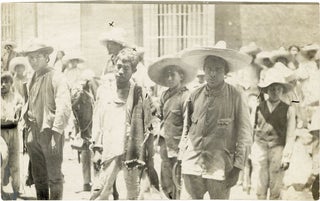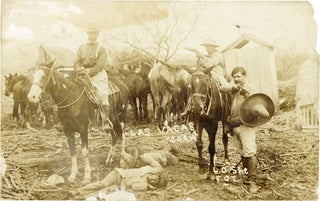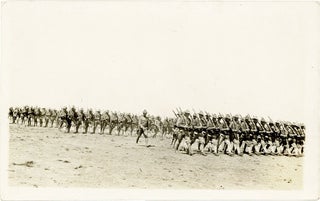![[Item #47618] Archive of Eighty-two Photographic Images of the Mexican-American Border Wars in Texas, California and Mexico, 1908-1915. MEXICAN REVOLUTION - GUERRA DE LA FRONTERA, Photographers and Publishers.](https://lornebair.cdn.bibliopolis.com/pictures/47618.jpg?auto=webp&v=1713198913)
Archive of Eighty-two Photographic Images of the Mexican-American Border Wars in Texas, California and Mexico, 1908-1915
[Various publishers & dates]. Extensive photographic archive documenting events on both sides of the U.S.-Mexico Border during the Mexican Revolution, focused primarily on the Border Wars in Texas and the Veracruz Incident of 1914, comprised entirely of contemporary images, all but a few of which are original vintage prints. The collection includes:
• Sixty-one commercially-produced real-photo postcards, ca. 14cm x 9cm or the reverse;
• Six commercially-printed postcards using non-photographic processes (same dimensions);
• Three carte-de-visite portraits, ca 9cm x 6cm, mounted to cards;
• Eight small-format photographs (ranging from 14cm x 8cm to 11cm x 16cm), of which three appear to be commercial images;
• Three 8x10 (20cm x 25cm) photographic prints, printed at some later date from original plates but apparently not contemporary;
• One vintage 4x6 (10cm x 16cm) photograph mounted on board.
All but a dozen or so images are captioned in the negative, and most are additionally captioned in pencil, in a later hand, on verso. Approximately half the images include no photo credit; of those that do, we have identified the following photographers: W.H. Horne, D.W. Hoffman, [Walter P.] Hadsell, Van Zile & Chalk, and L.O. She.
Condition is generally Very Good. Two of the photo postcards are damaged, with abrasions to significant portions of image area; the remainder show various degrees of edge wear, aging, and creasing, but by and large image quality remains excellent. None of the postcards are postally used, though a few include brief contemporary notes on verso.
The refusal of Mexican President Porfirio Dîaz to cede power to his rival Francisco Madero in the elections of 1910 resulted in a violent, large-scale revolt by campesinos and leftists, setting off the thirty-year long Mexican Revolution. American involvement in the conflict began in 1911, when President William H. Taft, under the guise of heightening border security, moved to back Díaz against the rebels. The resulting mobilization – Taft sent more than 20,000 American troops, nearly a quarter of all American forces, to the Mexican border, with especially heavy concentrations in Texas and New Mexico – was to that date the largest mobilization of American military forces in peacetime. At the same time, many Americans whose sympathies were not aligned with the Díaz dictatorship, including anarchists, wobblies, Native Americans, and more than a few soldiers of fortune, went south to fight on the side of the rebels. The resulting border conflict, which took place over nearly a decade, occasionally pitting American insurrectos against American Federal troops, resulted in thousands of Mexican and hundreds of American deaths.
The Border Wars reached their climax around the period 1912-1914, which happened to coincide with a near-hysterical vogue for postcards among the American public. The result is that the Mexican Revolution is perhaps the first major armed conflict to have been extensively photo-documented in real time, and certainly the first to have had a significant mass audience for that documentation. At least three hundred commercial photographers have been identified in association with the Mexican Revolution, and they produced tens of thousands of images, ranging from the relatively innocuous (e.g. peaceful street and harbor scenes in Veracruz) to the horrific (lynchings and sidewalk cremations).
This entire range of content is represented in the current collection, along with portraits of most of the key players on the Mexican side, including El Presidente Porfirio Díaz; his primary rival (and successor), Francisco Madero; Madero's successor by coup, Victoriano Huerta; and various military figures including General Juan Navarro, Felipe Angeles Ramírez, and numerous others. Many of these semi-professional images (though produced with commercial intent, "professional" remains a guarded term in the context of what was essentially battlefield exploitation photography) are valuable for their almost off-hand depictions of violent day-to-day life on the contested border, including the casual destruction and acceptance of death, from both sides, that seemed to define this conflict. Of particular note are numerous of photographs of African-American troops (the so-called "Buffalo Soldiers") as well as at least one image depicting Native American soldiers in uniform. Locales represented include Camp Grossmont in California; El Paso and Laredo in Texas and their cross-border sister cities Juarez and Nuevo Laredo; Veracruz (site of the American incursion of 1914, known as the "Veracruz Incident"); and various unidentified encampments and battle sites in both Texas and Mexico.
A wide-ranging and compelling photographic collection, documenting not only a key period in U.S. military diplomacy – one which for better or worse set the tone for American-Mexican relations for the succeeding century – but also a tangible manifestation of the first widespread public incarnation in America of the picture-postcard as a vehicle for both propaganda and photojournalism.
Price: $4,500.00






